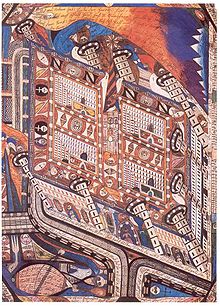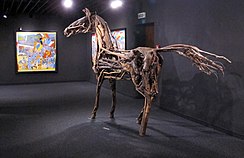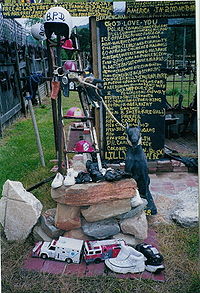Art Without Any Reference to Anything Outside Itself Is Often Called


Outsider art is fine art made by cocky-taught or supposedly naïve artists with typically little or no contact with the conventions of the art worlds. In many cases, their work is discovered only after their deaths. Often, outsider art illustrates extreme mental states, unconventional ideas, or elaborate fantasy worlds.
The term outsider art was coined in 1972 every bit the title of a book by fine art critic Roger Fundamental.[one] It is an English equivalent for fine art brut (French: [aʁ bʁyt], "raw fine art" or "rough art"), a label created in the 1940s by French artist Jean Dubuffet to depict art created outside the boundaries of official culture. Dubuffet focused particularly on art by those on the outside of the established fine art scene, using as examples psychiatric hospital patients, hermits, and spiritualists.[ii] [3]
Outsider art has emerged every bit a successful art marketing category; an annual Outsider Fine art Fair[4] has taken identify in New York since 1993, and there are at least 2 regularly published journals dedicated to the subject. The term is sometimes misapplied as a take hold of-all marketing label for art created by people who are outside the mainstream "art world" or "art gallery system", regardless of their circumstances or the content of their work.[5] A more specific term, "outsider music", was later adapted for musicians.
Art of the mentally sick [edit]
Interest in the art of the mentally ill, along with that of children and the makers of "peasant art", was kickoff demonstrated by "Der Blaue Reiter" group: Wassily Kandinsky, August Macke, Franz Marc, Alexej von Jawlensky, and others. What the artists perceived in the work of these groups was an expressive ability born of their perceived lack of composure. Examples of this were reproduced in 1912 in the first and only issue of their publication, Der Blaue Reiter Almanac. During Globe State of war I, Macke was killed at Champagne in 1914 and Marc was killed at Verdun in 1916; the gap left by these deaths was to some extent filled by Paul Klee, who connected to depict inspiration from these 'primitives'.
Interest in the art of insane asylum inmates continued to grow in the 1920s. In 1921, Dr. Walter Morgenthaler published his book Ein Geisteskranker als Künstler (A Psychiatric Patient as Artist) about Adolf Wölfli, a psychotic mental patient in his intendance. Wölfli had spontaneously taken up drawing, and this activity seemed to calm him. His near outstanding piece of work was an illustrated epic of 45 volumes in which he narrated his own imaginary life story. With 25,000 pages, 1,600 illustrations, and 1,500 collages, it is a awe-inspiring work. Wölfli also produced a large number of smaller works, some of which were sold or given as gifts. His work is on display at the Adolf Wölfli Foundation in the Museum of Fine Art, Bern.
A defining moment was the publication of Bildnerei der Geisteskranken (Artistry of the Mentally Ill) in 1922, by Hans Prinzhorn. This was the first formal study of psychiatric works, based upon a compilation of thousands of examples from European institutions. The volume and the fine art drove gained much attending from avant-garde artists of the time, including Paul Klee, Max Ernst, and Jean Dubuffet.[half dozen]
People with some formal artistic training also too-established artists are not immune from mental illness, and may also be institutionalized. For case, William Kurelek, later awarded the Order of Canada for his creative life work, as a young human being was admitted to the Maudsley Psychiatric Hospital where he was treated for schizophrenia.[7] In the hospital he painted, producing The Maze, a dark delineation of his tortured youth.[8] He was transferred from the Maudsley to Netherne Infirmary from November 1953 to January 1955, to work with Edward Adamson (1911–1996), a pioneer of art therapy, and creator of the Adamson Collection.
Jean Dubuffet and fine art brut [edit]

French creative person Jean Dubuffet was particularly struck by Bildnerei der Geisteskranken and began his ain collection of such art, which he chosen art brut or raw art. In 1948 he formed the Compagnie de 50'Fine art Brut forth with other artists, including André Breton. The collection he established became known as the Collection de l'art brut and the curator was Slavko Kopač for about iii decades.[9] It contains thousands of works and is now permanently housed in Lausanne, Switzerland.
Dubuffet characterized art brut as:
- "Those works created from confinement and from pure and authentic creative impulses – where the worries of competition, acclamation and social promotion do not interfere – are, because of these very facts, more precious than the productions of professionals. After a certain familiarity with these flourishings of an exalted feverishness, lived so fully and so intensely past their authors, we cannot avoid the feeling that in relation to these works, cultural art in its entirety appears to be the game of a futile society, a fallacious parade." — Jean Dubuffet. Place à 50'incivisme (Brand way for Incivism). Art and Text no.27 (December 1987 – February 1988). p.36 Dubuffet's writing on art brut was the subject of a noted program at the Art Club of Chicago in the early 1950s.
Dubuffet argued that 'culture', that is mainstream culture, managed to assimilate every new development in art, and past doing then took away whatsoever power it might have had. The result was to asphyxiate genuine expression. Art brut was his solution to this problem – only art brut was immune to the influences of culture, allowed to being absorbed and assimilated, considering the artists themselves were not willing or able to be assimilated.
Cultural context [edit]
The interest in "outsider" practices among twentieth-century artists and critics tin can exist seen equally part of a larger emphasis on the rejection of established values within the modernist art milieu. The early function of the 20th century gave rise to Cubism and the Dada, Constructivist and Futurist movements in art, all of which involved a dramatic motility away from cultural forms of the past. Dadaist Marcel Duchamp, for instance, abased "painterly" technique to allow chance operations a role in determining the grade of his works, or but to recontextualize existing "gear up-made" objects as fine art. Mid-century artists, including Pablo Picasso, looked exterior the traditions of loftier civilization for inspiration, drawing from the artifacts of "archaic" societies, the unschooled art fabricated by children, and vulgar advertising graphics. Dubuffet's championing of the art brut – of the insane and others at the margins of society – is however another example of avant-garde art challenging established cultural values.
Terminology [edit]


Two images of Joe Minter's African Village in America, a half-acre visionary art surround in Birmingham, Alabama. Scenes include African warriors watching their descendants' struggles in Alabama, tributes to blackness scientists and military leaders, recreations of the epic civil rights confrontations in Alabama, and biblical scenes.
A number of terms are used to depict art that is loosely understood as "outside" of official civilisation. Definitions of these terms vary and overlap.[10] The editors of Raw Vision, a leading journal in the field, advise that "Whatever views we have about the value of controversy itself, it is of import to sustain creative word by way of an agreed vocabulary". Consequently, they lament the employ of "outsider artist" to refer to well-nigh whatsoever untrained artist. "It is not plenty to be untrained, clumsy or naïve. Outsider Art is virtually synonymous with Art Brut in both spirit and pregnant, to that rarity of art produced by those who do non know its name."
- Art Brut: literally translated from French means "raw art"; 'raw' in that it has not been through the 'cooking' procedure: the world of art schools, galleries, museums. Originally art by psychotic individuals who existed almost completely outside civilisation and social club. Strictly speaking it refers but to the Collection de l'art brut.
- Folk fine art: Folk art originally suggested crafts and decorative skills associated with peasant communities in Europe – though presumably it could equally utilize to whatsoever indigenous culture. Information technology has broadened to include any production of practical adroitness and decorative skill – everything from chain-saw animals to hub-cap buildings. A key distinction betwixt folk and outsider art is that folk art typically embodies traditional forms and social values, where outsider fine art stands in some marginal relationship to gild's mainstream.
- Intuitive art/Visionary art: Raw Vision Magazine 'due south preferred general terms for outsider art. It describes them equally deliberate umbrella terms. Yet, visionary art, unlike other definitions here tin can often refer to the subject matter of the works, which includes images of a spiritual or religious nature. Intuitive fine art is probably the most general term available. Intuit: The Center for Intuitive and Outsider Art based in Chicago operates a museum dedicated to the study and exhibition of intuitive and outsider art. The American Visionary Art Museum in Baltimore, Maryland is dedicated to the collection and display of visionary art.
- Marginal art/Art singulier: Essentially the same as Neuve Invention; refers to artists on the margins of the art earth.
- Naïve art: Another term unremarkably applied to untrained artists who aspire to "normal" artistic condition, i.due east. they have a much more witting interaction with the mainstream art globe than exercise outsider artists.
- Neuve invention: Used to depict artists who, although marginal, have some interaction with mainstream culture. They may be doing art part-time for instance. The expression was coined by Dubuffet besides; strictly speaking, it refers just to a special role of the Collection de 50'art brut.
- Visionary environments: Buildings and sculpture parks built by visionary artists – ranging from decorated houses to big areas incorporating a large number of private sculptures with a tightly associated theme. Examples include Watts Towers by Simon Rodia, Buddha Park and Sala Keoku by Bunleua Sulilat, and The Palais Ideal past Ferdinand Cheval.
Notable outsider artists [edit]
See likewise [edit]
- Avant-garde
- Asemic writing
- Automated writing
- Category: Outsider artists
- Collection de l'art brut
- David Bowie'southward art collection and Outside (1995)
- Exoticism
- Glam stone
- Horror vacui
- Kitsch
- Lille Métropole Museum of Modern, Contemporary and Outsider Art
- Lowbrow (art motility)
- Neurodiversity
- Orientalism
- Outsider music
- Psychedelic art
- Racial fetishism
- Romantic racism
- Saving and Preserving Arts and Cultural Environments
- Schizoid personality disorder
- Surrealism
- Syncretism
- Unilalianism
- Vernacular architecture
- Earth music
- Xenocentrism
References [edit]
- ^ Conley, Katharine (2006). "Surrealism and Outsider Fine art: From the 'Automatic Bulletin' to André Breton's Drove". Yale French Studies, no. 109 (2006): 129–43.
- ^ Cardinal, Roger (1972). Outsider Art. New York: Praeger. pp. 24–xxx.
- ^ Bibliography The 20th Century Art Book. New York, NY: Phaidon Press, 1996.
- ^ "Outsider Art Fair". Outsider Art Fair . Retrieved 19 July 2014.
- ^ "What the Dickens is Outsider Art?" The Pantograph Punch, December 2016, retrieved 2017-01-sixteen
- ^ "Outsider Art Sourcebook" (Raw Vision, Watford, 2009, p.4)
- ^ Cornell case report: Early Onset Schizophrenia – William Kurelek
- ^ British Periodical of Psychiatry (2001)
- ^ Fabrice Flahutez, Pauline Goutain et Roberta Trapani, Slavko Kopač. Ombres et matières, Shadows and Materials, Paris : Gallimard, Hors série Connaissance, 2022 352 p. (ISBN 978-2-07-295610-ii)
- ^ Brut Force. "The Many Terms in Our Continuum". Brut Force . Retrieved 8 February 2017.
Further reading [edit]
- Bandyopadhyay, S. and I. Jackson, The Collection, the Ruin and the Theatre: architecture, sculpture and landscape in Nek Chand's Rock Garden, Chandigarh Liverpool, Liverpool Academy Press, 2007.
- Greg Bottoms, I Colori dell'Apocalisse – Viaggi nell'outsider art, Odoya, Bologna 2009 ISBN 978-88-6288-026-viii
- Greg Bottoms, The Colorful Apocalypse: Journeys in Outsider Art, Chicago: Academy of Chicago Press, 2007 ISBN 978-0-226-06685-1
- Roger Cardinal, Art Brut. In: Dictionary of Art, Vol. 2, London, 1996, p. 515–516.
- Marc Decimo, Les Jardins de 50'art brut, Les presses du réel, Dijon (France), 2007.
- Turhan Demirel, "Outsider Bilderwelten", Bettina Peters Verlag, 2006, ISBN three-939691-44-5
- Jean Dubuffet: L'Art brut préféré aux arts culturels [1949](=engl in: Fine art brut. Madness and Marginalia, special result of Art & Text, No. 27, 1987, p. 31–33).
- Hal Foster, Blinded Insight: On the Modernist Reception of the Fine art of The Mentally Ill. In: October, No. 97, Summer 2001, pp. 3–thirty.
- Michael D. Hall and Eugene W. Metcalf, eds., The Artist Outsider: Inventiveness and the Boundaries of Culture Washington D.C.: Smithsonian Institution Scholarly Press, 1993. ISBN 978-1560983354
- Deborah Klochko and John Turner, eds., Create and Be Recognized: Photography on the Border, San Francisco: Chronicle Books, 2004.
- John G. MacGregor, The Discovery of the Fine art of the Insane. Princeton, Oxford, 1989.
- David Maclagan, Outsider Fine art: From the margins to the market, London: Reaktion books, 2009.
- John Maizels, Raw Creation art and beyond, Phaidon Printing Express, London, 1996.
- John Maizels (ed.), Outsider Art Sourcebook. Raw Vision, Watford, 2009. ISBN 978-0-9543393-ii-half dozen
- Lucienne Peiry, Fine art brut: The Origins of Outsider Art, Paris: Flammarion, 2001.
- Lucienne Peiry (ed.), "Collection de l'Art Brut, Lausanne", Skira Flammarion, 2012.
- Lyle Rexer, How to Wait at Outsider Art, New York:Abrams, 2005.
- Colin Rhodes, Outsider Fine art: Spontaneous Alternatives, London: Thames and Hudson, 2000.
- Rubin, Susan Goldman. (March 9, 2004). Art Against the Odds: From Slave Quilts to Prison house Paintings. Publisher: Crown Books for Young Readers. ISBN 0-375-82406-v
- Michel Thévoz, Art brut, New York, 1975.
- Maurice Tuchman and Ballad Eliel, eds. Parallel Visions. Modern Artists and Outsider Art. Exhb. true cat. Los Angeles County Museum of Fine art, Los Angeles, 1992.
- Bianca Tosatti, Arte e psichiatria. Uno sguardo sottile, (in collaboration with Giorgio Bedoni), Mazzotta, Milano, 2000.
- Bianca Tosatti, Les Fascicules de fifty'Fine art brut', united nations saggio sull'artista Antonio dalla Valle,2007.
- Allen S. Weiss, Shattered Forms, Fine art Brut, Phantasms, Modernism, Country University of New York, Albany, 1992.
- Self Taught Artists of the 20th Century: An American Anthology San Francisco: Chronicle Books, 1998
- Daniel Wojcik, Outsider Art: Visionary Worlds and Trauma. University Printing of Mississippi, 2016.
External links [edit]
- Jeanine Taylor Folk Fine art – Purveyor of Outsider Art
- Raw Vision Magazine – International art magazine devoted to outsider fine art
- Gricha-rosov.com – Rich database and presentation of international outsider artists (in French language, simply has extensive illustrations)
- Outsider Artists in the Collection of Museum of Naive and Marginal Fine art (MNMA) Jagodina Serbia
- Russian outsider art from the Bogemskaja-Turchin collection
- Outsider Art news, wire, and announcements
- Collection: "Folk, Cocky-Taught, Apprentice, and Visionary Art" at the University of Michigan Museum of Art
Source: https://en.wikipedia.org/wiki/Outsider_art
0 Response to "Art Without Any Reference to Anything Outside Itself Is Often Called"
Post a Comment